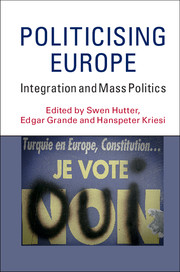Book contents
- Frontmatter
- Contents
- List of figures
- List of tables
- List of contributors
- Preface and acknowledgements
- Part I Theory and methods
- Part II Mapping the politicisation of European integration
- Part III Driving forces and consequences of politicisation
- 6 Constitutive issues as driving forces of politicisation?
- 7 The radical right as driving force in the electoral arena?
- 8 Framing Europe: are cultural-identitarian frames driving politicisation?
- 9 Politicisation, conflicts and the structuring of the EU political space
- 10 The euro crisis: a boost to the politicisation of European integration?
- Part IV Conclusions
- Methodological Appendix: measuring politicisation, benchmarks and data
- Bibliography
- Index
6 - Constitutive issues as driving forces of politicisation?
from Part III - Driving forces and consequences of politicisation
Published online by Cambridge University Press: 05 March 2016
- Frontmatter
- Contents
- List of figures
- List of tables
- List of contributors
- Preface and acknowledgements
- Part I Theory and methods
- Part II Mapping the politicisation of European integration
- Part III Driving forces and consequences of politicisation
- 6 Constitutive issues as driving forces of politicisation?
- 7 The radical right as driving force in the electoral arena?
- 8 Framing Europe: are cultural-identitarian frames driving politicisation?
- 9 Politicisation, conflicts and the structuring of the EU political space
- 10 The euro crisis: a boost to the politicisation of European integration?
- Part IV Conclusions
- Methodological Appendix: measuring politicisation, benchmarks and data
- Bibliography
- Index
Summary
Introduction
So far, we have shown that European integration has been politicised on various occasions and in different political arenas during the past four decades. However, the intensity and patterns of politicisation vary significantly across arenas, countries and over time. To understand and explain this variation, this chapter – as the first of a group of three chapters – puts the spotlight on the substantive content of the conflicts and its implications for politicisation. Our central hypothesis is that constitutive issues, a specific type of European issue, are a driving force of politicisation. Thus, we set out to answer the following two questions. Is the politicisation of Europe triggered by constitutive issues? Are constitutive issues positively related to higher levels of politicisation?
Constitutive issues relate to the very nature of the EU polity. Such issues involve questions related to the typical problems of regional integration introduced in Chapter 1, i.e., authority transfer, membership and decision-making rules (see Bartolini 2005: 310). Policy-related issues, by contrast, relate to questions about how in their policy-making European institutions make use of the competencies they have been attributed. Since these issues correspond to similarly structured national issues, such as, economic, social and environmental policies, they have been labelled ‘isomorphic issues’ by Bartolini (2005: 310). In contrast to consolidated national political systems, the EU polity is still in the making, and this continually raises questions about its functional and territorial boundaries. When political actors fight over such constitutive issues – be it over competencies (‘deepening’) or membership (‘widening’) – they thus touch upon the crucial elements of the European political system. This can be expected to trigger more intense opposition than policy-related European issues, and these conflicts may cut across existing party alliances, while policy-related issues tend to be more firmly embedded along traditional left–right conflict lines (e.g. Hoeglinger 2012; Hooghe and Marks 2009; Kriesi 2007; Kriesi et al. 2008, 2012; Statham and Trenz 2013a).
In this chapter, we answer our central questions by systematically differentiating between constitutive and policy-related European issues and by studying their consequences for the level of politicisation in both electoral and protest politics. Since debates on integration steps offer no fair test of our guiding hypothesis because the selection strategy is biased towards constitutive aspects of European integration, we do not consider them in this analysis.
- Type
- Chapter
- Information
- Politicising EuropeIntegration and Mass Politics, pp. 137 - 155Publisher: Cambridge University PressPrint publication year: 2016
- 12
- Cited by



